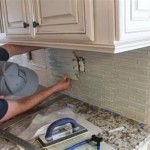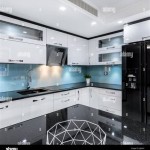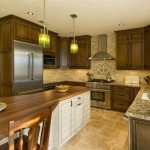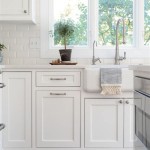Light Fixtures Over Kitchen Sink: Illumination and Functionality
The kitchen sink is a frequently used workstation in any home. It serves purposes ranging from food preparation to cleaning, demanding adequate and appropriate lighting. Selecting the right light fixture above the kitchen sink is crucial for ensuring both functionality and enhancing the overall aesthetic appeal of the kitchen. A well-lit sink area promotes safety, efficiency, and visual comfort, making daily tasks more manageable and enjoyable.
Effective kitchen sink lighting should provide ample illumination without creating glare or casting shadows. The placement, type, and style of the light fixture must be carefully considered in relation to the size and layout of the kitchen, as well as the overall design scheme. Several factors contribute to the optimal lighting solution for this critical area, including the height of the ceiling, the presence of cabinets or shelves above the sink, and the direction of natural light.
Understanding the Importance of Task Lighting
Task lighting is specifically designed to illuminate a particular work area, making it essential for spaces like the kitchen sink. Unlike ambient lighting, which provides overall illumination for a room, task lighting focuses a concentrated beam of light on the surface where tasks are performed. This concentrated light reduces eye strain, improves visibility, and enhances safety during food preparation and cleanup activities.
In the context of the kitchen sink, task lighting ensures that users can clearly see what they are doing, whether washing dishes, rinsing vegetables, or performing other kitchen-related tasks. Insufficient lighting in this area can lead to accidents, such as cutting oneself while chopping food or missing spots while cleaning dishes. Therefore, a dedicated light fixture above the sink is not merely a decorative element; it is a functional necessity.
The intensity of task lighting above the kitchen sink should be appropriate for the specific tasks being performed. Too little light can strain the eyes, while too much light can create glare and discomfort. The ideal level of illumination will vary depending on individual preferences and the specific conditions of the kitchen environment. Understanding the principles of adequate task lighting is crucial for selecting the right fixture and ensuring a safe and efficient workspace.
Exploring Different Types of Light Fixtures Suitable for Kitchen Sinks
A variety of light fixtures can be used above the kitchen sink, each offering different advantages in terms of aesthetics, functionality, and energy efficiency. The choice of the appropriate fixture depends on several factors, including the size and style of the kitchen, the height of the ceiling, and the desired level of illumination. Common options include pendant lights, recessed lights, track lights, and under-cabinet lights.
Pendant lights are suspended from the ceiling by a chain, cord, or rod, and they provide a decorative and functional lighting solution. They are available in a wide range of styles, from minimalist designs to ornate chandeliers, allowing for customization to match the kitchen's décor. Pendant lights can provide focused task lighting directly over the sink, but it is essential to ensure they are hung at the appropriate height to avoid obstructing the view or creating glare.
Recessed lights are installed flush with the ceiling, providing a clean and unobtrusive lighting solution. They are particularly suitable for kitchens with low ceilings or for those who prefer a minimalist aesthetic. Recessed lights can be strategically placed to provide even illumination across the sink area, and they can be combined with other types of lighting to create a layered lighting scheme.
Track lights consist of multiple light heads mounted on a track, allowing for adjustable and directional lighting. They are ideal for kitchens where flexibility is desired, as the light heads can be repositioned to focus light on specific areas. Track lights can be used to highlight architectural features or to provide task lighting over the sink and other work surfaces.
Under-cabinet lights are installed beneath the upper cabinets, providing focused task lighting directly on the countertop and sink area. They are particularly effective for illuminating areas that may be shadowed by overhead cabinets. Under-cabinet lights are available in various forms, including LED strips, puck lights, and linear fixtures, and they can be easily installed and integrated into the kitchen design.
When selecting a light fixture for above the kitchen sink, considering the energy efficiency of the light source is essential. LED bulbs are a popular choice due to their long lifespan, low energy consumption, and ability to provide bright and consistent light. They are also available in a range of color temperatures, allowing users to customize the ambiance of the kitchen.
Factors to Consider When Choosing a Light Fixture
Selecting the right light fixture for the kitchen sink involves considering several key factors. These factors include the size of the sink area, the height of the ceiling, the style of the kitchen, and the desired level of illumination. Ignoring these factors can lead to unsatisfactory results, such as inadequate lighting, glare, or a mismatch with the overall kitchen design.
Size and Scale: The size of the light fixture should be proportional to the size of the sink area. A large pendant light may overwhelm a small sink area, while a small recessed light may not provide enough illumination for a larger sink. Carefully measuring the dimensions of the sink area and the surrounding space is essential for selecting a fixture that is appropriately sized.
Ceiling Height: The height of the ceiling plays a significant role in determining the type of light fixture that is suitable. In kitchens with low ceilings, recessed lights or flush-mount fixtures are often the best choice, as they do not hang down and obstruct the view. In kitchens with high ceilings, pendant lights or track lights can be used to bring the light closer to the work surface.
Kitchen Style: The style of the light fixture should complement the overall design of the kitchen. A modern kitchen may benefit from sleek and minimalist fixtures, while a traditional kitchen may be better suited to more ornate and decorative fixtures. Considering the existing design elements, such as cabinets, countertops, and backsplash, is essential for selecting a fixture that harmonizes with the kitchen's aesthetic.
Light Output and Color Temperature: The amount of light produced by the fixture, measured in lumens, should be sufficient to provide adequate task lighting for the sink area. The color temperature of the light, measured in Kelvin, affects the ambiance of the kitchen. Warmer light (around 2700K) creates a cozy and inviting atmosphere, while cooler light (around 4000K) provides a more focused and energetic feel. The choice of color temperature should be based on personal preferences and the overall design goals.
Ease of Installation and Maintenance: The ease of installation and maintenance should also be considered when selecting a light fixture. Some fixtures may require professional installation, while others can be easily installed by a homeowner with basic electrical knowledge. Similarly, some fixtures may require more frequent cleaning and maintenance than others. Considering these factors can save time and money in the long run.
Glare and Shadows: One of the most important considerations is to minimize glare and shadows. Light fixtures should be positioned to avoid direct glare in the user's eyes, and they should provide sufficient illumination to eliminate shadows on the work surface. Using light diffusers or shades can help to soften the light and reduce glare. Properly positioned under-cabinet lighting can help alleviate shadows caused by overhead cabinets.
Proper wiring and electrical safety are paramount during installation. If there's any doubt about the electrical work, hiring a qualified electrician is always recommended to ensure the installation is done safely and according to local codes.
By carefully considering these factors, homeowners and designers can select the right light fixture for the kitchen sink, ensuring both functionality and aesthetic appeal. Adequate task lighting is essential for creating a safe, efficient, and enjoyable kitchen environment.

Choosing The Best Light Over Your Kitchen Sink Steel Lighting Co

Rustic Farmhouse Light For Country Decor Wooden Beam Ceiling Fixture Kitchen Strip Replacement With Hanging Pendant Lights Etsy

Favorite Flush Mount Light Fixtures And New Sink Nesting With Grace

How To Light Up The Kitchen Sink With Style Inspiration Barn Electric

Kitchen Lighting Ideas The Home

Lighting Over Kitchen Sink Design Ideas

The 15 Best Over Kitchen Sink Lighting Ideas Lightopia

Over Kitchen Sink Lighting How To Enlighten Your Cooking Space

Top American Made Farmhouse Light Fixtures Steel Lighting Co

Galvanized Laundry Wash Tub Ceiling Light








